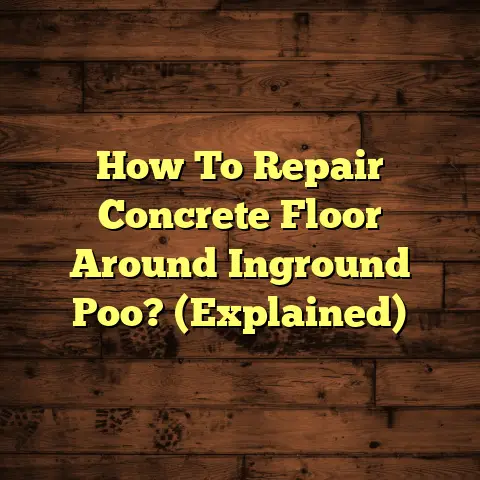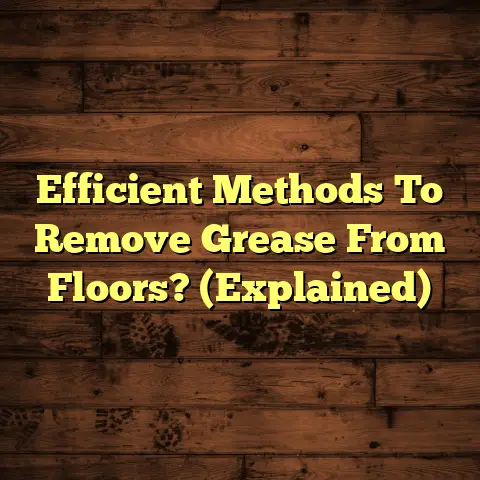DIY Floor Sander/Buffer? (4 Machines Compared!)
Would you rather spend your weekends battling stubborn floor finishes with a rented sander that feels like wrestling an alligator, or transform your living space with a powerful DIY floor sander/buffer sitting pretty in your garage?
I know which option I’d pick!
As a flooring contractor with over 15 years under my belt, I’ve seen it all – from disastrous DIY attempts to stunning transformations.
And let me tell you, the right tool makes all the difference.
This article is your ultimate guide to choosing the best floor sander/buffer for your DIY projects.
We’ll dive deep into four different machines, comparing their strengths, weaknesses, and ideal uses.
Get ready to ditch the rental headaches and unleash your inner flooring pro!
Understanding Floor Sanders and Buffers
Okay, let’s get the basics down. What are floor sanders and buffers?
Simply put, they’re power tools designed to smooth, refine, and polish your floors. But there’s a key difference:
-
Floor Sanders: These are the heavy hitters. They use abrasive sandpaper to remove old finishes, imperfections, and even out the surface of your floor. Think of them as the “reset” button for your hardwood.
-
Floor Buffers: These are the finesse artists. They use pads to polish, clean, and apply finishes to your floor, leaving it with a beautiful sheen. Think of them as the “finishing touch” that brings your floor to life.
Why are these tools so important for DIY projects?
Well, if you’re planning to refinish your hardwood floors, you need a sander to remove the old finish and create a smooth surface for the new one.
And if you want to maintain the shine and luster of your floors, a buffer is your best friend.
Now, choosing the right machine is crucial.
Using a drum sander on laminate? Disaster!
A buffer that’s too weak for your concrete floors? Useless!
Different flooring types require different approaches, and we’ll get into the specifics later.
Criteria for Comparison
Alright, before we jump into the machines themselves, let’s establish some ground rules. What makes a good floor sander/buffer?
Here are the key criteria I use when evaluating these tools:
-
Power (Horsepower and Motor Type): More power means faster sanding and buffing, especially on tough finishes. Look for horsepower ratings and consider the motor type (induction vs. universal). Induction motors are generally more durable and quieter.
-
Weight and Portability: Lugging a heavy machine around is exhausting. Consider the weight and whether it has features like wheels or a folding handle for easy transport.
-
Ease of Use and Ergonomics: Is it easy to control? Are the handles comfortable? Can you adjust the height? These factors impact your comfort and the quality of your work.
-
Sanding/Buffing Speed and Efficiency: How quickly can it remove material or polish the floor? Variable speed settings are a plus for different tasks.
-
Dust Collection Capabilities: Sanding creates a lot of dust. A good dust collection system is essential for your health and the cleanliness of your workspace.
-
Price Range and Value for Money: How much does it cost, and what do you get for your money? Consider the features, performance, and overall quality.
-
Durability and Warranty: Will it last? A longer warranty is a good sign of the manufacturer’s confidence in the product.
Machine Comparisons
Okay, let’s get to the fun part! I’ve chosen four DIY floor sanders/buffers that represent a range of options and price points.
Machine 1: Clarke American Sanders B-1 Buffer
-
Specifications:
- Motor: 1.5 HP
- Pad Size: 17 inch
- Weight: 94 lbs
- Speed: 175 RPM
- Dust Collection: No
- Price Range: $1,200 – $1,500
- Warranty: 1 Year
-
Pros:
- Durable construction.
- Easy to use.
- Great for polishing and buffing.
-
Cons:
- Heavy and not very portable.
- No dust collection.
- Not suitable for heavy sanding.
-
Ideal Use Cases: Polishing hardwood floors, applying wax, cleaning carpets (with the right attachment).
-
Real User Review: “This buffer is a workhorse! It’s simple to operate and leaves my floors looking amazing. The weight helps to keep it stable.” – John S.
Machine 2: Festool Rotex RO 150 FEQ
-
Specifications:
- Motor: 720 Watts
- Pad Size: 6 inch
- Weight: 4.9 lbs
- Speed: 300 – 600 RPM (Rotex Mode), 3,000 – 6,000 RPM (Random Orbit Mode)
- Dust Collection: Yes (with vacuum)
- Price Range: $600 – $700 (bare tool)
- Warranty: 3 Years (with registration)
-
Pros:
- Versatile: can be used for both sanding and polishing.
- Lightweight and easy to maneuver.
- Excellent dust collection when used with a Festool vacuum.
- High-quality construction.
-
Cons:
- Expensive, especially when you factor in the cost of a vacuum.
- Small pad size means it’s not ideal for large areas.
- Steeper learning curve.
-
Ideal Use Cases: Sanding and polishing smaller areas, detail work, sanding furniture, preparing surfaces for finishing.
-
Real User Review: “This sander is a game-changer! The Rotex mode is incredibly aggressive for removing material, and the random orbit mode leaves a flawless finish. It’s worth the investment.” – Sarah M.
Machine 3: VonHaus Cordless Floor Polisher & Scrubber
-
Specifications:
- Motor: Cordless, Battery Powered
- Pad Size: 10 inch
- Weight: 7.7 lbs
- Speed: 110 RPM
- Dust Collection: No
- Price Range: $100 – $130
- Warranty: 2 Years
-
Pros:
- Cordless and lightweight for easy maneuverability
- Affordable
- Easy to use
-
Cons:
- Not for heavy duty work
- Battery life is limited
- No dust collection
-
Ideal Use Cases: Light cleaning, polishing, and waxing of hard floors
-
Real User Review: “This is great for quick cleanups and polishing. I love that it’s cordless and easy to store.” – Emily R.
Machine 4: PowerMate 2-in-1 Orbital Floor Sander/Buffer
-
Specifications:
- Motor: 4.8 amp
- Pad Size: 12 inch
- Weight: 15.4 lbs
- Speed: 3200 OPM
- Dust Collection: No
- Price Range: $130 – $160
- Warranty: 2 Year Limited Warranty
-
Pros:
- Affordable
- Lightweight
- Easy to switch between sanding and buffing
-
Cons:
- Not for heavy duty sanding
- No dust collection
- Can be a bit shaky
-
Ideal Use Cases: Light sanding, buffing, and polishing of floors
-
Real User Review: “For the price, this is a great little machine. It’s perfect for small projects and touch-ups.” – Michael B.
Detailed Analysis of Each Machine
Let’s dig a little deeper into each machine and see how they perform in different scenarios.
Clarke American Sanders B-1 Buffer:
- Flooring Types: Best suited for hardwood, tile, and concrete. It can handle carpet with the right attachment.
- Maintenance: Simple. Just keep the pads clean and inspect the motor occasionally.
- Noise and Vibration: Relatively quiet for its size, but you’ll still want hearing protection. Vibration is minimal.
- Best Practices: Use overlapping passes and let the weight of the machine do the work. Don’t force it.
Festool Rotex RO 150 FEQ:
- Flooring Types: Versatile enough for hardwood, laminate, and even some types of stone. Not ideal for large concrete floors.
- Maintenance: Requires regular cleaning of the dust extraction system. The pads are high-quality but need to be replaced as they wear.
- Noise and Vibration: Lower noise levels than larger sanders. Vibration is minimal, especially in random orbit mode.
- Best Practices: Experiment with different sanding grits and speeds to find the optimal settings for your project. Use a Festool vacuum for maximum dust collection.
VonHaus Cordless Floor Polisher & Scrubber:
- Flooring Types: Best for tile, laminate, and sealed hardwood.
- Maintenance: Keep the pads clean and charge the battery regularly.
- Noise and Vibration: Very quiet with minimal vibration.
- Best Practices: Use appropriate cleaning solutions and polishing compounds for best results.
PowerMate 2-in-1 Orbital Floor Sander/Buffer:
- Flooring Types: Suitable for hardwood, laminate, and tile floors.
- Maintenance: Clean the pads regularly and check for wear.
- Noise and Vibration: Moderate noise and some vibration.
- Best Practices: Start with a low grit sandpaper and gradually increase to achieve the desired smoothness.
Choosing the Right Sander/Buffer for Your Project
Okay, so which machine is right for you?
Here’s a breakdown to help you decide:
-
Flooring Type:
- Hardwood: Festool Rotex RO 150 FEQ (for smaller areas), Clarke American Sanders B-1 Buffer (for polishing), PowerMate 2-in-1 Orbital Floor Sander/Buffer (for light sanding).
- Laminate: Festool Rotex RO 150 FEQ, VonHaus Cordless Floor Polisher & Scrubber, PowerMate 2-in-1 Orbital Floor Sander/Buffer.
- Tile: Clarke American Sanders B-1 Buffer (for cleaning and polishing), VonHaus Cordless Floor Polisher & Scrubber.
- Concrete: Clarke American Sanders B-1 Buffer (for polishing).
-
Project Scope:
- Small Projects (e.g., refinishing a small room, sanding furniture): Festool Rotex RO 150 FEQ, PowerMate 2-in-1 Orbital Floor Sander/Buffer.
- Large Projects (e.g., refinishing an entire house): Clarke American Sanders B-1 Buffer.
- Routine Maintenance (e.g., polishing, cleaning): VonHaus Cordless Floor Polisher & Scrubber.
-
Skill Level:
- Beginner: Clarke American Sanders B-1 Buffer, VonHaus Cordless Floor Polisher & Scrubber, PowerMate 2-in-1 Orbital Floor Sander/Buffer.
- Intermediate/Advanced: Festool Rotex RO 150 FEQ (requires more finesse).
-
Budget:
- Budget-Friendly: VonHaus Cordless Floor Polisher & Scrubber, PowerMate 2-in-1 Orbital Floor Sander/Buffer.
- Mid-Range: Clarke American Sanders B-1 Buffer.
- High-End: Festool Rotex RO 150 FEQ.
Here are a few scenarios to consider:
-
Scenario 1: You want to refinish your entire hardwood floor yourself. You’ll need a powerful sander to remove the old finish and level the floor. You’ll also need a buffer to apply the new finish and polish the floor. The Clarke American Sanders B-1 Buffer would be a good choice for the buffing stage.
-
Scenario 2: You want to lightly sand and refinish a small piece of furniture. The Festool Rotex RO 150 FEQ would be perfect for this task. It’s versatile, lightweight, and offers excellent dust collection.
-
Scenario 3: You want to regularly clean and polish your tile floors. The VonHaus Cordless Floor Polisher & Scrubber is a great option for this. It’s affordable, easy to use, and cordless for maximum convenience.
Conclusion
Choosing the right floor sander/buffer can be a game-changer for your DIY projects.
Each of the machines we’ve discussed has its strengths and weaknesses.
The Clarke American Sanders B-1 Buffer is a durable workhorse for polishing large areas.
The Festool Rotex RO 150 FEQ is a versatile and high-quality option for smaller projects.
The VonHaus Cordless Floor Polisher & Scrubber is an affordable and convenient choice for routine maintenance.
The PowerMate 2-in-1 Orbital Floor Sander/Buffer is a budget-friendly option for light sanding and buffing.
Take your time, consider your needs, and choose the machine that’s right for you.
With the right tool in hand, you’ll be able to achieve professional-looking results and transform your living space.
Happy sanding (and buffing)!





